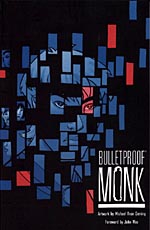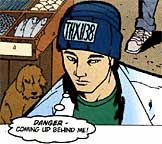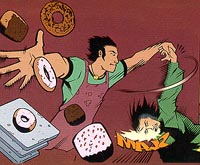>> Comment: Appointments With Disappointment
>> Comment: Accentuate The Positive?
More...

 Writers: Brett Lewis and RA Jones
Writers: Brett Lewis and RA Jones
Artist: Michael Avon Oeming
Colourists: Mike Garcia & Heather Martin, Digital Chameleon, BAD@SS
Letterers: Robbie Robins, Digital Chameleon, Idea & Design Works
Inker: Jason Baumgartner
Collecting BULLETPROOF MONK #1-#3
Price: $9.95
Publisher: Image Comics
ISBN: 1-58240-244-2
Falling uncomfortably between the superheroism of which comics laughably revolves and the indie highbrow intellectualism of most of its self-publishing successes is a Third Place. An oeuvre, a milieu, a brand that gets short thrift in the popular comics press, itself bifurcated to meet the demands of the two towers of comics production.
This Third Place has no activists or guerrilla marketing techniques or loud-mouthed proponents. Its members care little for movements and have none of the hang-ups of the rest of the industry. This Third Place doesn't have a name, but if it did, it would be 'mainstream'.
Which brings us to BULLETPROOF MONK. Initially published through Image by Flypaper Press, the three-issue mini came and went and the world failed to burn. Indeed, this silence is one of the major hallmarks of any Third Place comics. For any comic to be recognised by fandom, it must be hailed by an identifiable group of people, not just a large collection of individuals. There are no groups of Third Place fans; there are just lots of individuals who feel no need to espouse their opinions to like-minded individuals.
The individual issues utilised an abstract cover that seemed solely designed to draw attention to its most unique selling factor; its title. A title invoking bizarre Hong Kong chop-socky epics filled with Eastern mysticism mixed with a little John Woo double-fisted action. Cracking open the first issue might have left you a little disappointed in that respect, but soon the realisation would dawn that this was something better. This series isn't about the literal truth of the title, but the metaphorical discovery.
Lung Kai Yun or 'Kar', lives in America with his uncle. He didn't always live in America, having been spirited away by his parents after their arrest in Tibet for undisclosed political reasons. His only remaining heirloom is a talisman around his neck that bears the words "Bulletproof Monk". The Monk, Kar is led to understand, was a mysterious figure of the thirties and forties who protected the people of Tibet from Nazi experimentation and then stepped back into Legend, never to be seen again.
 It's the talisman that starts the story and ends it, getting Kar into trouble with a local gang leader during the opening. The first issue depicts his - at first - adversarial contact with the gang which leads into a fast friendship and eventually love with the gang member known as Daughter. With the death of Daughter's father, she is tasked with taking the reins of his criminal empire, and things get serious very quickly. Kar soon realises that the only person who can help him is the Monk, and sets off on a voyage of discovery that is more personal than physical.
It's the talisman that starts the story and ends it, getting Kar into trouble with a local gang leader during the opening. The first issue depicts his - at first - adversarial contact with the gang which leads into a fast friendship and eventually love with the gang member known as Daughter. With the death of Daughter's father, she is tasked with taking the reins of his criminal empire, and things get serious very quickly. Kar soon realises that the only person who can help him is the Monk, and sets off on a voyage of discovery that is more personal than physical.
The complex production credits make it hard to tell who was responsible for what, but there is a definite pitch-shift over the course of the three issues. The first issue, written by Brett Lewis, is a wonderful slice-of-life drama about young people. Lulling you into a false sense of nothingness, you miss how much you've actually been shown. It sets in motion a potentially interesting new breed of comic, part teen-movie, part kung-fu blockbuster.
With a little help on the second issue and complete ownership of the third, RA Lewis brings a new slant to the work. It has now become Kar's story. A story that revolves around his quest to find the Monk. The jarring change isn't just stylistically evident, but translates directly into plot at the exact moment that the relationship between Kar and Daughter shifts. By the end of the third issue, it has become an out-and-out action movie with conspiratorial double-crossing and automatic weapons fire.
One element of the comic that never fails to impress is the artwork from a pre-POWERS Michael Avon Oeming and his inker, Jason Baumgartner. Whereas his self-inked work on police-procedural POWERS is predominantly grounded in reality, with occasional flourishes of the fantastic, this earlier work allows Oeming to experiment with what can only be called Psychedelic Manga. Oeming's panel borders disintegrate and warp and spasm off into the infinite with a myriad design elements bringing the work to life. His cut-back iconic detail is enhanced by Baumgartner's tight, more realistic inks.
 Working hand-in-hand with the artwork is the colours. Despite having three different colourists (one per issue), the book retains a consistent tone and look. The colours are occasionally saturated a little on the paper stock chosen to print this collection, but their vital boldness and colour-wheel-defying choices never seem too dulled. Indeed, the entire book's design is impeccable, from the unique covers of each issue to the restrained and individual look of the book's trade dress. Praise must go to designer Bill Ticineto for his work.
Working hand-in-hand with the artwork is the colours. Despite having three different colourists (one per issue), the book retains a consistent tone and look. The colours are occasionally saturated a little on the paper stock chosen to print this collection, but their vital boldness and colour-wheel-defying choices never seem too dulled. Indeed, the entire book's design is impeccable, from the unique covers of each issue to the restrained and individual look of the book's trade dress. Praise must go to designer Bill Ticineto for his work.
That the book's ending might not be as surprising as hoped doesn't belittle the genuine intelligence of the work. The book's core premise expertly presents an updated version of the mythology of Buddhism for a western audience. Tying it all up in a surprisingly effective tale of teenage discovery is a genuinely innovative move.
Which brings us back to the work's membership of the Third Place and its upcoming cellular adaptation. How many comics currently published could boast an introduction from John Woo? How many comics currently published would John Woo - Or any director of a similar calibre - be interested in? Could you see Doug Liman doing THE AVENGERS? The Wachowskis on WONDER WOMAN? Robert Rodriguez on YOUNG JUSTICE?
Because the Third Place is about writing comics that anybody could enjoy. It's about populist entertainment; works for the masses. It's for the people who only ever buy books in airports, or visit the cinema not just as an adjunct to their Film Theory Degree, or turn on the TV just to see what's on. People who don't want to read your theories on fifteenth century painting versus the over-intellectualism of modern conceptual art. People who don't care whether Dr Midnight might have actually been gay or what happened off-panel in Issue 495. People who just want to enjoy, not be consumed.
BULLETPROOF MONK's imminent screen arrival will be a bold statement for any potential Third Place creators wondering what to do next. It's a book that firmly plants itself in a mainstream culture centred around the young, unsubtle and brash. Yet it doesn't revel in anything, it doesn't let itself become about itself. And it doesn't allow its cross-culturally unspecific mission statement drag it down into the mire of mediocrity. It's mainstream and it's good. And if John Woo likes it, then who are you to argue?

This article is Ideological Freeware. The author grants permission for its reproduction and redistribution by private individuals on condition that the author and source of the article are clearly shown, no charge is made, and the whole article is reproduced intact, including this notice.


